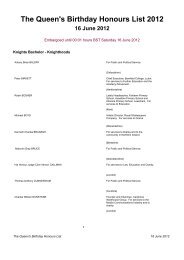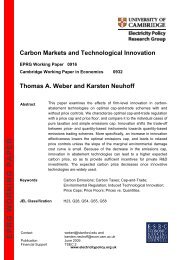EPRG WORKING PAPER - Electricity Policy Research Group
EPRG WORKING PAPER - Electricity Policy Research Group
EPRG WORKING PAPER - Electricity Policy Research Group
Create successful ePaper yourself
Turn your PDF publications into a flip-book with our unique Google optimized e-Paper software.
Figure 3: Real Energy Prices and Energy E¢ ciency Improvements in the U.S. PetrochemicalIndustry5 Simulated E¤ects of Greenhouse Gas Emissions TaxThe results of the vintage capital model indicate that energy-price induced improvementsin capital stock are signi…cant in determining the future energy e¢ ciency of productionin three out of …ve industries analyzed in this study.These …ndings imply that energyand climate policies that provide incentives for early investment in energy e¢ cient capitalstock may reduce future energy (including fossil fuel) input consumption. To illustrate theoutcome of such policies we use the vintage capital model predictions to evaluate the e¤ectof a greenhouse emissions tax on energy consumption. Speci…cally, we simulate the e¤ect ofthe greenhouse gas (carbon dioxide, CO 2 ) emissions tax implemented in 2005 in the U.K.petrochemical industry.We assume that all input prices except for the energy price and output remain at their2005 levels (e.g. Y i;t = w j=k;l;mi;t = 0; t > 2005). The capital stock stays constant, andthe vintage investment o¤sets capital stock depreciation (e.g. x k i;t>2005 = x k i;2005; I i;l>2005 =(1 ) x k i;2005). Based on the results of the vintage capital model (see Table 3 and Table 5d,Appendix 1) we assume the rate of exogenous technological change = 0:032, the own-priceelasticity of energy e¢ ciency of capital stock e = 0:89; and the own-price elasticity of energydemand for the U.K. petrochemical industry ee =0:58. Because EU KLEMS dataset does11






